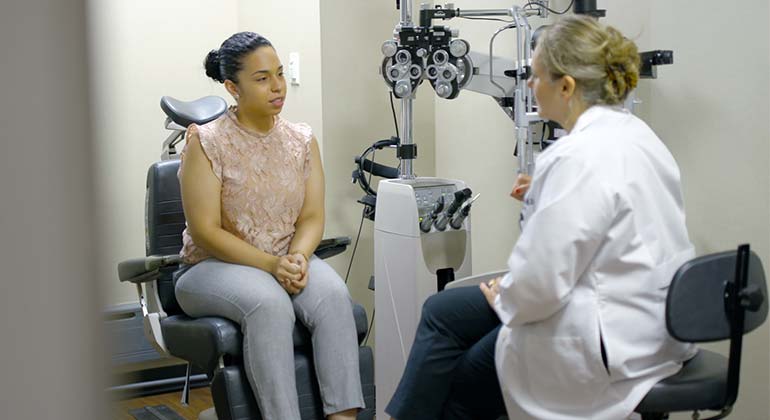Andalusia Pediatrics Clinics: Dedicated Take Care Of Your Child's Health
Wiki Article
The Pros and Cons of Various Refractive Surgeries for Improved Eyecare

LASIK Surgical Procedure
LASIK surgery is a frequently performed refractive procedure that intends to remedy vision issues such as astigmatism, farsightedness, and nearsightedness. During the procedure, a slim flap is developed on the cornea, and a laser is utilized to reshape the underlying tissue, dealing with the refractive mistake.One of the primary benefits of LASIK surgery is the quick enhancement in vision experienced by several people. The majority of people notice a significant improvement in their eyesight soon after the treatment, with marginal downtime required for healing. Additionally, LASIK is known for its high success price and low incidence of difficulties when executed by proficient specialists. However, like any surgery, LASIK likewise lugs some dangers, including dry eyes, glare, halos, and under or overcorrection of vision. It is important for individuals taking into consideration LASIK surgical procedure to undertake a complete examination by an eye care expert to determine if they appropriate prospects for the procedure.
PRK Treatment
The PRK procedure, likewise recognized as Photorefractive Keratectomy, is a kind of refractive surgical procedure that aims to correct vision issues similar to LASIK surgery. Unlike LASIK, which involves creating a flap in the cornea, PRK functions on the surface area layer of the cornea.One of the benefits of PRK over LASIK is that it removes the risk of flap-related complications since no flap is developed throughout the surgery. Despite the longer recovery period, PRK can be an ideal choice for individuals seeking vision correction surgery.
SMILE Surgical Treatment
An innovative refractive surgical procedure technique obtaining popularity in the area of ophthalmology is SMILE Surgery. Little Incision Lenticule Extraction (SMILE) is a minimally intrusive treatment that deals with vision by reshaping the cornea using a femtosecond laser. Unlike conventional LASIK surgical procedure, SMILE Surgery entails developing a little cut in the cornea to remove a lenticule, which results in less disturbance to the corneal framework and potentially quicker recovery times.Among the primary benefits of SMILE Surgery is its capacity to treat nearsightedness (nearsightedness) and astigmatism with high precision, bring about exceptional visual results for people. The minimally invasive nature of the treatment additionally lowers the risk of problems such as dry eye syndrome, making it a desirable choice for people looking for refractive surgical treatment.

LASEK Strategy
Having checked out the benefits and factors to consider of SMILE Surgical procedure, an additional significant refractive surgical procedure method worth examining is the LASEK Strategy. LASEK, which represents Laser-Assisted Subepithelial Keratectomy, is a kind of laser eye surgical procedure that aims to remedy refractive errors such as myopia (nearsightedness), hyperopia (farsightedness), and astigmatism.Unlike LASIK, LASEK does not entail producing a corneal flap. Rather, during a LASEK procedure, the specialist makes use of a diluted alcohol option to loosen the thin outer layer of the cornea, called the epithelium. This layer is then carefully moved aside to allow the laser to improve the underlying corneal cells. As soon as the cornea has actually been improved to the preferred degree, the epithelial layer is repositioned.
One of neurologist Andalusia the key advantages of LASEK is that it can be appropriate for individuals with slim corneas who might not be good prospects for LASIK. In addition, LASEK usually results in marginal post-operative discomfort and a quicker recovery time compared to PRK. Nonetheless, the visual recuperation process with LASEK might be somewhat longer than with LASIK.
Implantable Contact Lenses
Implantable Contact Lenses use a long-term vision modification solution for individuals seeking an alternative to traditional get in touch with lenses or glasses. These lenses, additionally called phakic intraocular lenses, are operatively inserted into the eye to deal with refractive mistakes such as myopia (nearsightedness), hyperopia (farsightedness), and astigmatism. andalusia pediatrics. Unlike typical contact lenses that sit on the surface area of the eye, implantable contact lenses work within the eye itself, supplying clear vision without the demand for daily maintenance or elimination
Among the essential benefits of implantable call lenses is their permanence. When inserted, they can remain in the eye indefinitely, using regular and steady vision improvement. Additionally, these lenses can be an outstanding choice for people that are bad candidates for laser eye surgical treatment or who favor a relatively easy to fix vision improvement treatment.
However, implantable contact lenses do carry some dangers, including the capacity for cataracts or boosted eye stress. It is vital for individuals considering this alternative to seek advice from an eye treatment specialist to establish if implantable call lenses are the right choice for their specific needs and eye health.
Conclusion
Finally, each kind of refractive surgical treatment has its own advantages and disadvantages. LASIK surgical procedure is preferred for its fast recuperation time, while PRK treatment may be suitable for clients with thin corneas. SMILE surgery offers marginal discomfort throughout the treatment, however LASEK method may have a longer recovery procedure. Implantable get in touch with lenses give a choice for those who are not suitable prospects for conventional surgeries. Patients must talk to their eye care provider to determine the best alternative for their individual needs.
Generally, SMILE Surgery provides an encouraging option for people looking to enhance their vision via refractive surgery.
Report this wiki page